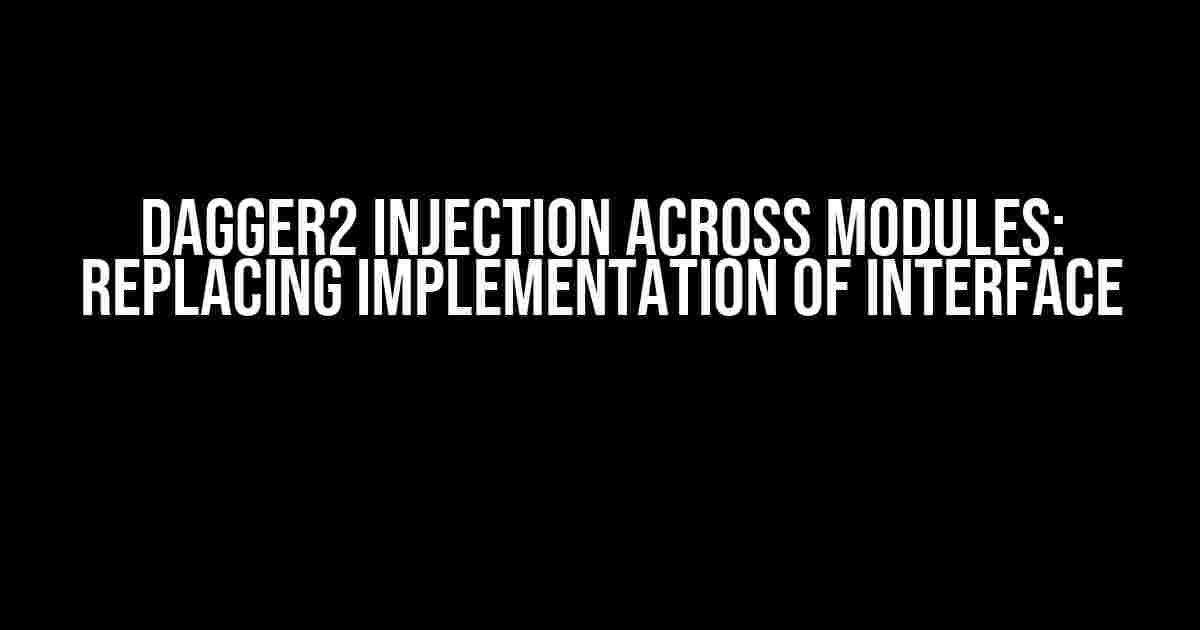Introduction
In modern Android app development, Dependency Injection (DI) is a crucial concept that helps to decouple components and make the code more modular, testable, and maintainable. Dagger2 is a popular DI framework that simplifies the process of injecting dependencies across modules. In this article, we will explore how to use Dagger2 injection across modules to replace the implementation of an interface.
The Problem: Tight Coupling
In a typical Android app, different modules often have tight coupling, where one module directly instantiates and uses an implementation of an interface. This approach leads to several issues, including:
- Tight coupling makes it difficult to change or replace the implementation of an interface without affecting other modules.
- It becomes challenging to test individual modules in isolation, as they are closely tied to specific implementations.
- Modularity and reusability are compromised, making it harder to maintain and scale the app.
The Solution: Dagger2 Injection
Dagger2 provides a elegant solution to this problem by allowing us to inject implementations of interfaces across modules. By using Dagger2, we can:
- Decouple modules from specific implementations, making it easier to change or replace them without affecting other modules.
- Write more modular and reusable code, making it easier to maintain and scale the app.
- Write unit tests for individual modules in isolation, without worrying about the implementation details of other modules.
Step-by-Step Guide
To demonstrate how to use Dagger2 injection across modules, let’s consider a simple example. Suppose we have two modules: NetworkModule and RepositoryModule. The RepositoryModule depends on an interface ApiInterface, which is implemented by the NetworkModule.
Step 1: Define the Interface
First, we define the ApiInterface in a separate package:
public interface ApiInterface {
@GET("/users")
Call<List<User>> getUsers();
}
Step 2: Implement the Interface
Next, we implement the ApiInterface in the NetworkModule:
public class ApiServiceImpl implements ApiInterface {
@Inject
Retrofit retrofit;
@Override
public Call<List<User>> getUsers() {
return retrofit.create(ApiInterface.class).getUsers();
}
}
Step 3: Create a Module for the Implementation
We create a module for the ApiServiceImpl implementation:
@Module
public class NetworkModule {
@Provides
ApiInterface provideApiInterface(ApiServiceImpl apiServiceImpl) {
return apiServiceImpl;
}
}
Step 4: Create a Component for the Module
We create a component for the NetworkModule:
@Singleton
@Component(modules = NetworkModule.class)
public interface NetworkComponent {
void inject(RepositoryModule repositoryModule);
}
Step 5: Use the Interface in Another Module
Finally, we use the ApiInterface in the RepositoryModule:
@Module
public class RepositoryModule {
@Inject
ApiInterface apiInterface;
@Provides
public UserRepository provideUserRepository(ApiInterface apiInterface) {
return new UserRepository(apiInterface);
}
}
Conclusion
In this article, we have seen how to use Dagger2 injection across modules to replace the implementation of an interface. By decoupling modules from specific implementations, we can write more modular, testable, and maintainable code. With Dagger2, we can easily switch between different implementations of an interface, making it easier to maintain and scale our Android app.
References
Here is the FAQ about Dagger2 injection across modules replacing implementation of Interface:
Frequently Asked Questions
Are you curious about how Dagger2 injection works across modules and replaces implementation of Interface? We’ve got you covered!
What is the main advantage of using Dagger2 injection across modules?
The main advantage is that it allows you to decouple modules and still provide instances of interfaces without having to manually create them. This makes your code more modular, flexible, and easier to maintain!
How does Dagger2 injection work across modules?
Dagger2 creates a graph of objects and their dependencies. When you annotate an interface with @Inject, Dagger2 creates an instance of the implementation class and provides it to the dependent modules. This way, you can use the interface without knowing the implementation details!
What is the role of the @Module and @Provides annotations in Dagger2 injection?
The @Module annotation defines a module that provides instances of interfaces, while the @Provides annotation specifies the implementation class that will be used to create the instance. This way, you can specify which implementation to use for a particular interface!
Can I use Dagger2 injection to replace implementation of multiple interfaces in a single module?
Yes! Dagger2 allows you to provide multiple implementations for different interfaces in a single module. Just annotate each interface with @Inject and provide the corresponding implementation class using @Provides, and Dagger2 will take care of the rest!
What are the benefits of using Dagger2 injection across modules instead of manual implementation?
By using Dagger2, you avoid tight coupling between modules, reduce boilerplate code, and make your code more modular, flexible, and testable. It’s a win-win-win situation!
